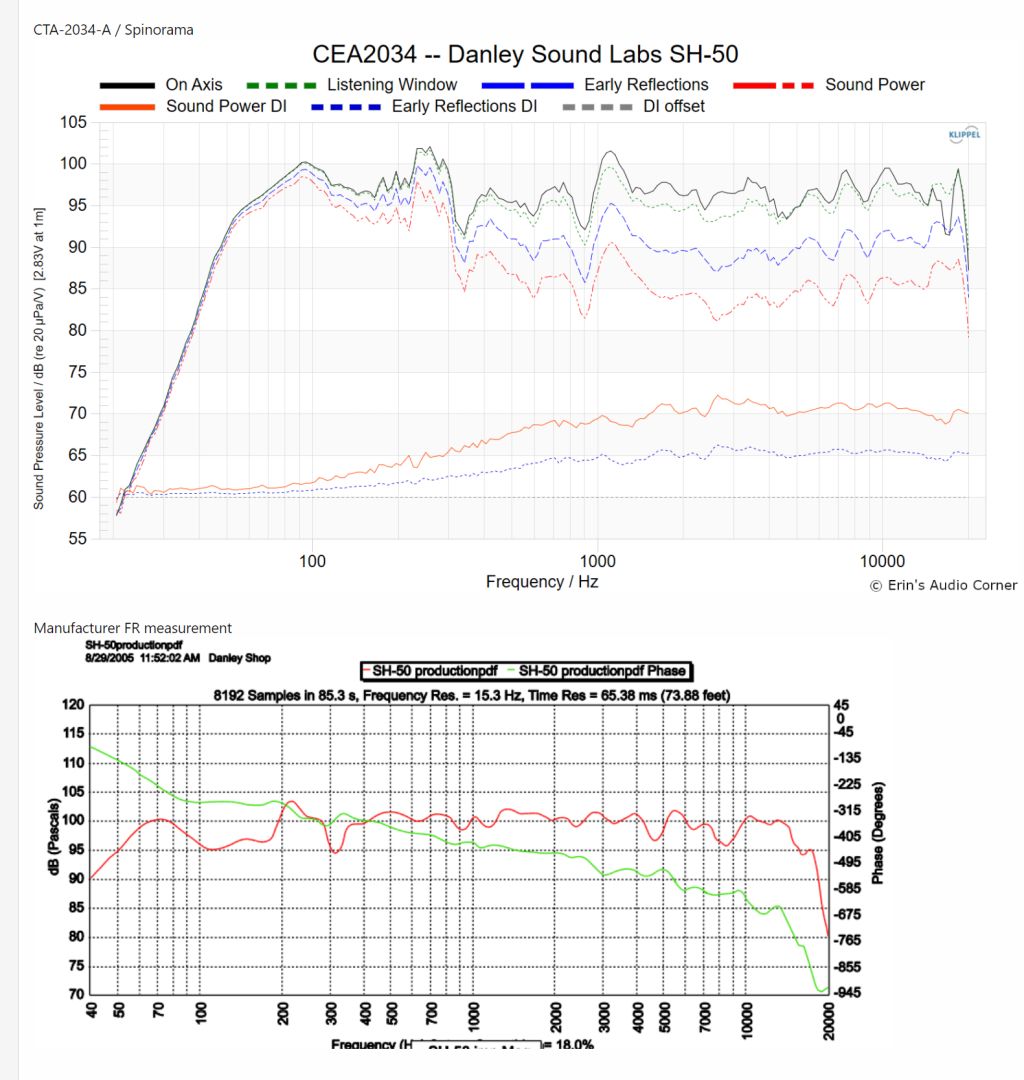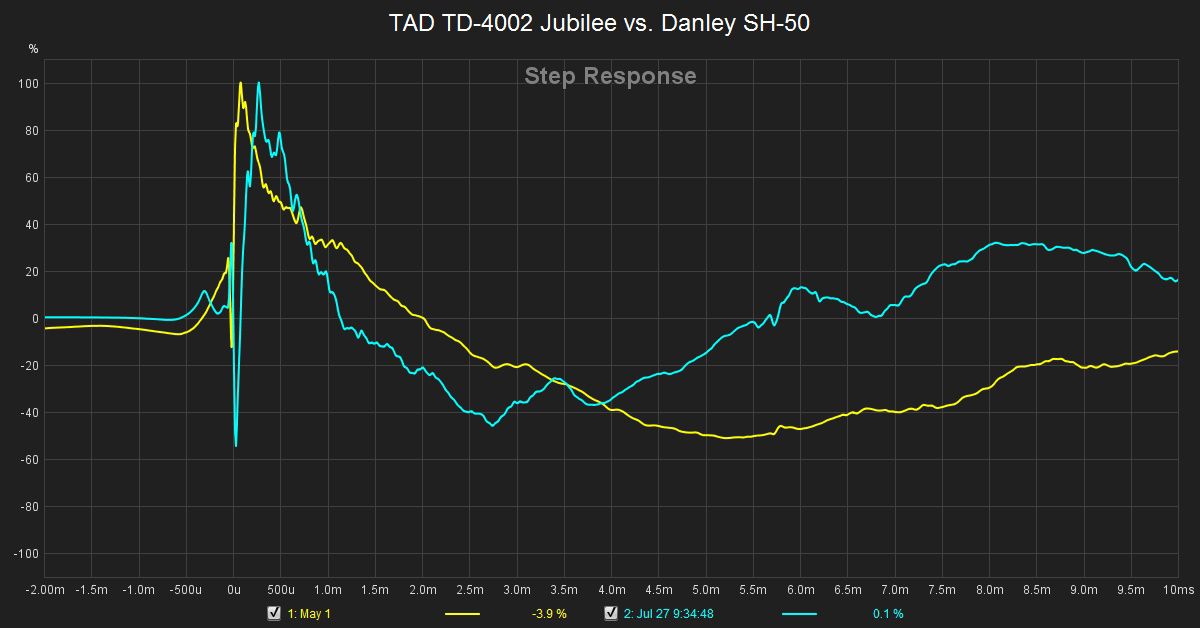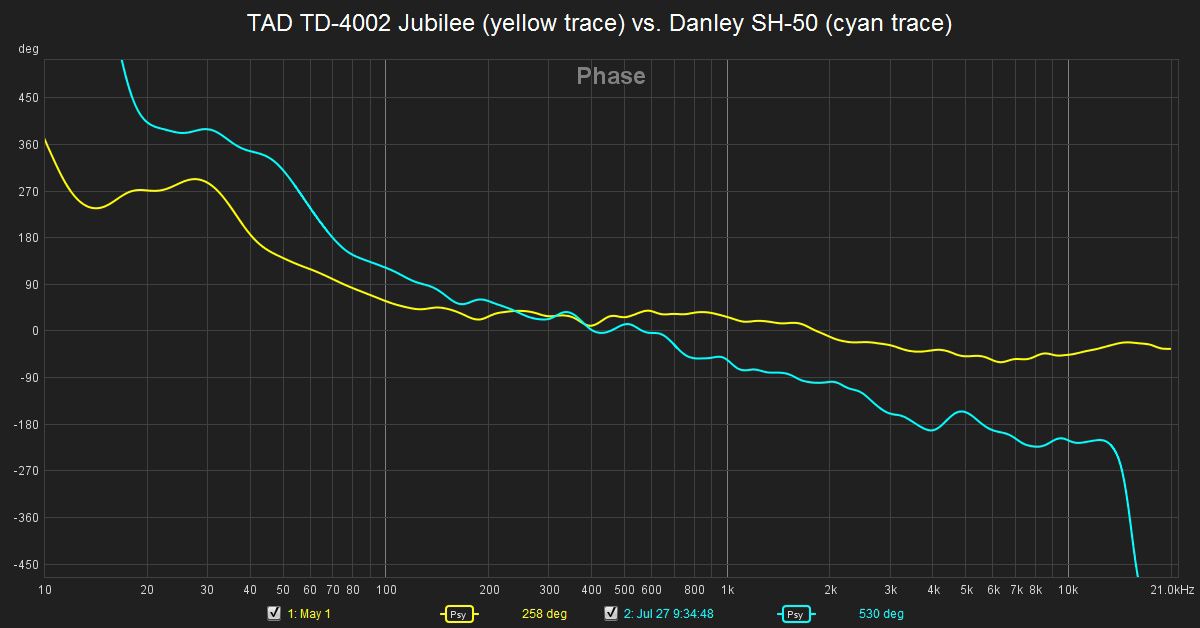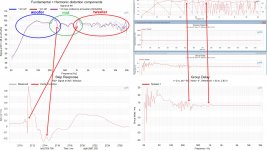It is a shame that more people don't copy Tom's grace and online communication style as often as they copy his speakers.Mr. Danley proves yet again what a patient and kind soul he is.
When the message comes with such a condescending tone the content is often dismissed along with the delivery.Perhaps more on that subject later--and not in this thread (or perhaps this forum, if it continues to drift toward "lowest common denominator" behavior).
Too bad there's all that bickering back and forth. Wouldn't it have been great to see NFS data of the K-402-MEH? 🙄
Thank you Erin, for your dedication of getting this kind of data to us all. Much appreciated.
Thank you Erin, for your dedication of getting this kind of data to us all. Much appreciated.
When the message comes with such a condescending tone the content is often dismissed along with the delivery.
That "message" it is merely a postscript comment to return to the subject of this thread and to maintain that focus on the Hyperion (not the K-402-MEH)...without ad hominem attacks...nothing more.
I actually said a lot more than that...which is the real message.
Too bad there's all that bickering back and forth. Wouldn't it have been great to see NFS data of the K-402-MEH? 🙄
Erin would have to bring the NFS to my abode to measure it because I'm not ready to let mine go anywhere but where it is in my setup, i.e., the center between Jubilees. Perhaps one of the others that have built their own might oblige...but good luck with that.
If you're ever through D/FW International airport, drop in for a listen to both the SH-50 and the K-402-MEH. (I'm okay with loaning out the SH-50, however. I find its horizontal coverage to be a bit narrow for my needs, but you might not.)
Has the conversation on the Hyperion itself reached its logical conclusion? ( I hope not.)
Chris
And I also understand the situation a lot better with Erin's rig. I think I see why he's so focused on the money thing right now. I also believe that I understand why he's investing in Klippel NFS--because people on forums like this won't listen to those that don't have $10K, $20K or even $100K test rigs (and I can think of one person on another forum that apparently started catering to that sort of thing...and that person isn't Erin).
Both of you have provided valuable contributions to this hobby of ours, but this bickering is incredibly cringey.
Thank you Erin for ground plane measurements! Surprisingly good match with NFS on-axis, but expected as per previous tests by you.
Regarding step response, it would be essential to know individual responses of woofer, mid and tweeter, to evaluate timing match between drivers. Impulse response in your attachment has very long time scale, so we can't compare it to the step response graph and impulse looks too good.
More info about 3-way step response analysis Measuring Loudspeakers, Part Two Page 3 | Stereophile.com
To me it looks like there is problems with midrange integration (timing) Step response peaks don't match like they sould. In group delay graph it even looks like mid pulse comes earlier than tweeter and woofer band is not smooth like it sould, and has timing mismatch with the mid.
Danley's claim for SH being time-coherent doesn't hold (at least for this version of SH-50) Multiway-dsp controlled crossover would most likely give much better results, even without FIR because of better response EQ and timing control. Fully digital Hyperion would be a killer for hifi, if one likes narrow directivity sound!
Regarding step response, it would be essential to know individual responses of woofer, mid and tweeter, to evaluate timing match between drivers. Impulse response in your attachment has very long time scale, so we can't compare it to the step response graph and impulse looks too good.
More info about 3-way step response analysis Measuring Loudspeakers, Part Two Page 3 | Stereophile.com
To me it looks like there is problems with midrange integration (timing) Step response peaks don't match like they sould. In group delay graph it even looks like mid pulse comes earlier than tweeter and woofer band is not smooth like it sould, and has timing mismatch with the mid.
Danley's claim for SH being time-coherent doesn't hold (at least for this version of SH-50) Multiway-dsp controlled crossover would most likely give much better results, even without FIR because of better response EQ and timing control. Fully digital Hyperion would be a killer for hifi, if one likes narrow directivity sound!
Attachments
I agree with you, Juhazi, and that's why I brought up the possibility that something isn't working correctly. Those measurements look funky. I think Erin knows how to measure a speaker, and that's why I suspect that something is broken or wired incorrectly.
A few years ago, I was doing a subjective listening session with one of my friends who's spent A LOT of time listening to speakers, and he was able to pinpoint that the speakers weren't wired correctly in literally one second.
I think there's something similar going on here, but it's not clear to me if it's an issue with the midrange wiring or the compression driver wiring. At first I'd assumed one or two of the mids were blown. Now that Erin has confirmed they're working properly, I'm beginning to wonder if the compression driver is wired out of phase.

If I'm right, that may explain the peak and the dip in the midrange. A tweeter wired out of phase would cause that.
A few years ago, I was doing a subjective listening session with one of my friends who's spent A LOT of time listening to speakers, and he was able to pinpoint that the speakers weren't wired correctly in literally one second.
I think there's something similar going on here, but it's not clear to me if it's an issue with the midrange wiring or the compression driver wiring. At first I'd assumed one or two of the mids were blown. Now that Erin has confirmed they're working properly, I'm beginning to wonder if the compression driver is wired out of phase.
If I'm right, that may explain the peak and the dip in the midrange. A tweeter wired out of phase would cause that.
"Patrick" (😉), you said:
"A few years ago, I was doing a subjective listening session with one of my friends who's spent A LOT of time listening to speakers, and he was able to pinpoint that the speakers weren't wired correctly in literally one second."
That's cool and all, but really doesn't help this particular case. If your friend knows how they are supposed to sound then it's easy to identify something is wrong. I haven't heard another of these speakers so my reference is this sole speaker so I can't say "yep, that doesn't sound like it should". I know it didn't sound fantastic to me, the data backs that up. But if I don't have a "golden sample" to reference then all I've got is what I've got on hand.
This speaker came off the rack in the warehouse and I saw the QC process of when speakers arrive back from the field (a few measurements to check the tolerances) and this makes me expect the speaker I took home with me is good to go as it was passed through the same QC check.
Again, I have shown Tom the data through a few measurements (he questioned some that were taken by another party before so I wanted to share with him what I got) and he hasn't said anything about them looking incorrect. If he had, I would have pulled everything apart to verify. And, I truly mean no offense, but all I have right now is your hunch to go on... if this were an easy speaker to take apart and then put back on the stand then I'd gladly do some basic troubleshooting. That isn't the case here, though. So, let me ask Tom directly what he thinks about your hypothesis. If he agrees with you then I'll do what I need to do to take this thing apart and check the wiring. Frankly, I would be happy to find this is the case... I'm not reluctant at all to remeasure if there is valid reason to. Other than trying to find someone to help me lift this monstrosity back on the stand... 130# lifted up 5 feet isn't something my wife can help me with. 😱
- Erin
"A few years ago, I was doing a subjective listening session with one of my friends who's spent A LOT of time listening to speakers, and he was able to pinpoint that the speakers weren't wired correctly in literally one second."
That's cool and all, but really doesn't help this particular case. If your friend knows how they are supposed to sound then it's easy to identify something is wrong. I haven't heard another of these speakers so my reference is this sole speaker so I can't say "yep, that doesn't sound like it should". I know it didn't sound fantastic to me, the data backs that up. But if I don't have a "golden sample" to reference then all I've got is what I've got on hand.
This speaker came off the rack in the warehouse and I saw the QC process of when speakers arrive back from the field (a few measurements to check the tolerances) and this makes me expect the speaker I took home with me is good to go as it was passed through the same QC check.
Again, I have shown Tom the data through a few measurements (he questioned some that were taken by another party before so I wanted to share with him what I got) and he hasn't said anything about them looking incorrect. If he had, I would have pulled everything apart to verify. And, I truly mean no offense, but all I have right now is your hunch to go on... if this were an easy speaker to take apart and then put back on the stand then I'd gladly do some basic troubleshooting. That isn't the case here, though. So, let me ask Tom directly what he thinks about your hypothesis. If he agrees with you then I'll do what I need to do to take this thing apart and check the wiring. Frankly, I would be happy to find this is the case... I'm not reluctant at all to remeasure if there is valid reason to. Other than trying to find someone to help me lift this monstrosity back on the stand... 130# lifted up 5 feet isn't something my wife can help me with. 😱
- Erin
Last edited:
Measurement of my SH-50 in-room (cyan trace), microphone at 1 metre compared to Jubilee using zeroth order crossover filters (yellow trace), taken 2 1/2 years ago in my listening room with plenty of absorption on the floor between the loudspeakers and microphone:

Chris

Chris
The key question here is, that as Erin et al. told, SH-50 has had several iterations of passive xo. We don't know details of each version, no less comparable measurements. We don't even know exactly, what was the reason for those iterations - lower distortion, smoother response, better impulse/step, better power handling etc.
Danley don't have to reveal that data to us, no way. But I'm left wondering... I have never heard a Danley MEH speaker and most likely never will, only some diy MEHs in small rooms, so this is a purely "academic" dilemma for me.
Danley don't have to reveal that data to us, no way. But I'm left wondering... I have never heard a Danley MEH speaker and most likely never will, only some diy MEHs in small rooms, so this is a purely "academic" dilemma for me.
I bought that SH-50 in July 2018 direct from the factory. I can provide a serial number (via PM--if it is absolutely necessary).
Chris
Chris
I believe that I side with Mr. Hardison in this case: I believe that you're imagining all kinds of ills that aren't, in fact, there.
Chris
Chris
Can you explain your rationale? I simply don't see how you got there.Maybe a (50) meter test would put things into perspective.
Chris
Maybe a (50) meter test would put things into perspective.
The NF/FF summation occurs around 1.50 meters (I mentioned this in my writeup).
You can see that from my groundplane measurement, there is practically no difference in the 2m vs 4m test and the only difference there is is directly attributed to the relative angle of the mic to the speaker (my driveway is slightly sloped; the mic is at the "higher" angle and, looking down, thus, more on-axis the further away it is placed).
Last edited:
The NF/FF summation occurs around 1.50 meters (I mentioned this in my writeup).
...and can you explain that assumption. My experience is that the convergence distance is actually negative, as measured from the horn's mouth.
Chris
Are you defining the far field as the distance where the timing of the edge diffraction becomes consistent on an axis?
The loudspeaker sums the output of the drivers internally in-phase. So, in effect, it is a point source with its acoustic center being quite steady vs. frequency (that's the phase measurement)--like one driver is playing, or in other words, effectively zero convergence distance. Only the internal delays of a single full-range driver would be applicable.
If you were measuring drivers on a flat baffle (i.e., a direct radiating loudspeaker), then there would be positive convergence distances between drivers. This thing literally measures like a single driver, however.
I think a lot of folks have missed the "acoustical summation" point that Tom made in his 1999 patent (US6411718).
You can also see this in Danley's EASE data on the SH-50.
Chris
If you were measuring drivers on a flat baffle (i.e., a direct radiating loudspeaker), then there would be positive convergence distances between drivers. This thing literally measures like a single driver, however.
I think a lot of folks have missed the "acoustical summation" point that Tom made in his 1999 patent (US6411718).
You can also see this in Danley's EASE data on the SH-50.
Chris
Last edited:
Well, let's consider the designs' (SH-50) intended use. Some of the conversation involves "possible" xo issues and/or component failure regarding frequency response. I don't believe, or expect, a design intended for auditorium/stadium use to scale the same for use in a typical home room environment. Therefore, other design consideration ie. high frequency air absorption, dispersion, multiple unit coupling, may inappropriately skew single unit near field results.Can you explain your rationale? I simply don't see how you got there.
Chris
Here is the phase of the SH-50 that I measured in my listening room vs. the Jubilee (again, cyan is the SH-50, yellow is the Jubilee). The phase of the SH-50 shows that there is a net 360 degrees of phase rotation over the range 60 Hz-14 kHz.
If what you are worried about is this movement of the acoustic center vs. frequency over its entire bandwidth (the entire loudspeaker), then the 1.5 meter number might have some meaning, but that would have to referenced from a datum behind the loudspeaker's mouth or throat by that distance, not in front of the loudspeaker--right?
Chris

If what you are worried about is this movement of the acoustic center vs. frequency over its entire bandwidth (the entire loudspeaker), then the 1.5 meter number might have some meaning, but that would have to referenced from a datum behind the loudspeaker's mouth or throat by that distance, not in front of the loudspeaker--right?
Chris

Last edited:
- Home
- Loudspeakers
- Multi-Way
- Danley Signature Series
